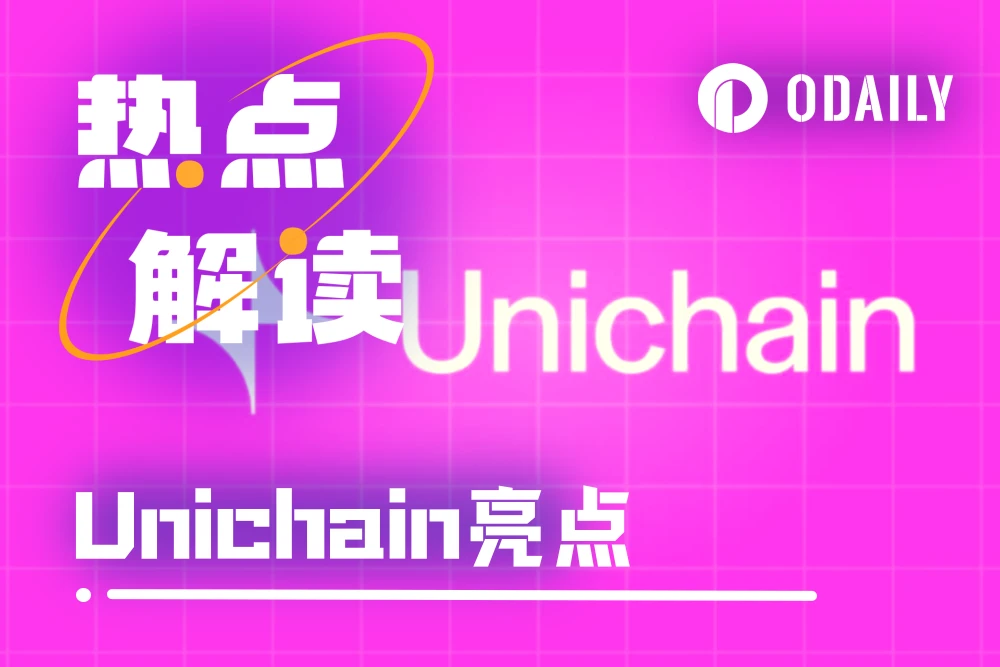Original | Odaily Planet Daily (@OdailyChina)
Author | Fu Ruo (@vincent31515173)

Since the launch of the AMM mechanism, Uniswap has been regarded as a benchmark in the DeFi industry. With the releases of V3, V4, and UniswapX, it has consistently shocked the market. However, most people view Uniswap merely as a DEX and do not see higher value in it, especially with the low empowerment of the governance token UNI, leading to decreasing attention.
But after Uniswap launched the L2 Unichain built on the Optimistic OP Stack yesterday, a high-speed, low-latency L2 dedicated to the DeFi sector may change perceptions of Uniswap's future development. The most direct reflection of this is the rapid increase in UNI's price, which surged to a high of 8.47 USDT, with an increase of over 15%, before gradually retreating to 7.9 USDT.

In the official white paper, Unichain is an L2 optimized for efficient markets, capable of providing rapid state updates, offering an internalized MEV (Maximal Extractable Value) framework for applications, and ensuring fast cross-chain settlement through an economic finality system.
The MEV framework and rapid settlement are the core highlights of this network, and the role of the UNI token within this network has become a focal point of discussion. Therefore, Odaily Planet Daily will address readers' questions based on the content of the official white paper.
UniChain Key Points Interpretation
Flashblocks + TEE, significantly reduced block construction time
Since the birth of DeFi in 2018, transaction speed has been a core issue. Compared to other high-speed chains like Solana, the low TPS of the Ethereum mainnet limits the speed of DeFi transactions, causing many well-known DeFi projects that originated on Ethereum, such as dYdX, to migrate. So, can Uniswap's launch of Unichain solve this problem?
According to official information, Unichain introduces a brand new block construction protocol—Verifiable Block Building, characterized by:
Effective block time of 200-250ms: Achieved by dividing each block into four "Flashblocks" for rapid transaction confirmation.
Transparent priority sorting: Ensures that the priority sorting of transactions within each Flashblock is public and transparent, allowing applications to return a portion of their MEV to users.
Trustless rollback protection: Simulates transactions through TEE (Trusted Execution Environment), detecting and removing potentially failed transactions, reducing the risk of users paying for failed transactions.
Each Flashblock requires 200-250ms, and forming a complete block takes about 1 second, which significantly reduces block generation time compared to the Ethereum mainnet or many Ethereum L2s.
Moreover, Unichain separates the roles of block construction and sorting. Block construction operations are executed within a Trusted Execution Environment (TEE), allowing external users to verify compliance with specified sorting rules. TEE requires dedicated hardware to implement; the last time we saw the concept of Trusted Execution Environment (TEE) was in privacy-focused public chains.
Currently, the TEE builder used by Unichain will run an open-source builder codebase on Intel's TDX hardware, which provides private data access and verifiable execution through its computational integrity properties. Execution proofs will be publicly released, allowing users to verify whether blocks are constructed according to specified policies within the TEE.
The benefit of this approach is to reduce block formation time and enhance on-chain efficiency. Additionally, TEE supports "rollback protection," ensuring that failed transactions do not appear in the final block, thereby reducing users' transaction risks.
MEV Framework
MEV has become a key issue in the DeFi sector, widely recognized since Paradigm invested in Flashbots.
In Unichain, the extraction of MEV (Maximal Extractable Value) is achieved through an innovative verifiable block building mechanism and transparent priority management.
First, Unichain introduces a verifiable block building protocol developed in collaboration with Flashbots, optimizing user experience by splitting each block into multiple "Flashblocks." This mechanism allows applications to allocate a portion of MEV to users, promoting market efficiency.
Second, the design of Flashblocks allows for clear management of transaction priorities, enabling users to specify particular Flashblocks for extraction. This transparent management not only reduces user risk but also enhances the efficiency of automated market makers (AMMs) and intent-based systems.
Additionally, the verifiable builder provides trustless Revert Protection, lowering the costs users incur due to transaction failures, further enhancing user confidence.
How does Unichain empower the UNI token?
The community has long fantasized about how Uniswap could empower the UNI token, but after nearly six years, there have been no surprises.
Essentially, for a Web3 project to empower its token, the primary prerequisite is that the token must participate in the project's actual operations. Previously, UNI, as a governance token, was mostly used for community voting, which gradually led to individual apathy over time. However, with the launch of Unichain, the decentralized governance of the network becomes the key to empowering the UNI token.
In the official white paper, Unichain not only introduces a brand new block construction protocol but also a decentralized verification network. The UniChain verification network reduces the risk of sorters proposing multiple conflicting or invalid blocks through decentralized verification by nodes, enhancing the finality of on-chain transactions.
Users must first stake UNI tokens on the Ethereum mainnet to become validators of Unichain. The amount of staked UNI will determine the weight and potential rewards of the validator. Validators will sign the legitimacy of blocks and publicly release these signatures at the end of each epoch, ensuring network transparency.
Thus, the long-awaited UNI token empowerment mechanism finally sees change, allowing users to stake UNI tokens to become validators of Unichain and earn potential rewards. The specific amount of rewards has not been explicitly stated by the official sources, but I predict it will come from gas fees or MEV-related income.
免责声明:本文章仅代表作者个人观点,不代表本平台的立场和观点。本文章仅供信息分享,不构成对任何人的任何投资建议。用户与作者之间的任何争议,与本平台无关。如网页中刊载的文章或图片涉及侵权,请提供相关的权利证明和身份证明发送邮件到support@aicoin.com,本平台相关工作人员将会进行核查。




